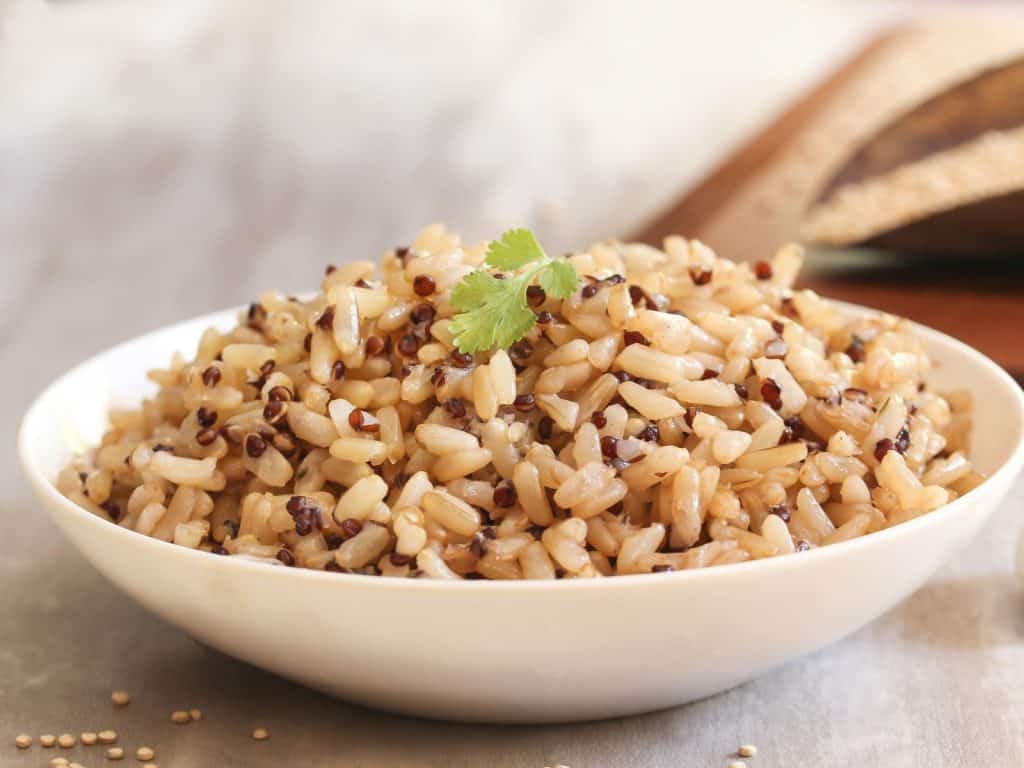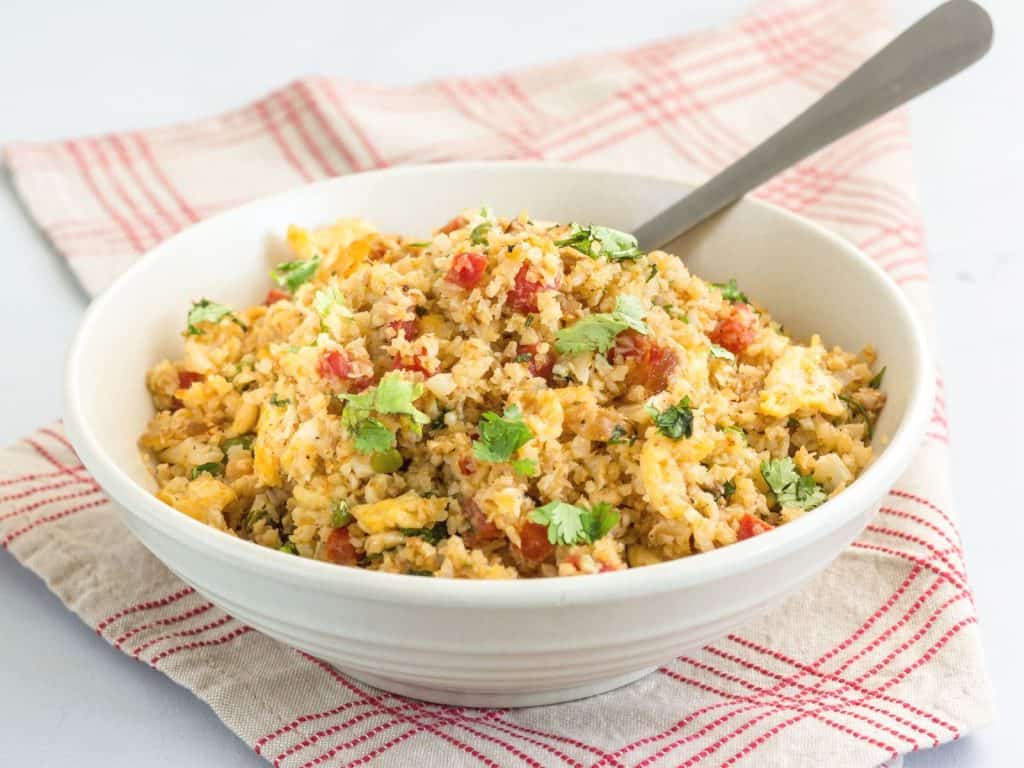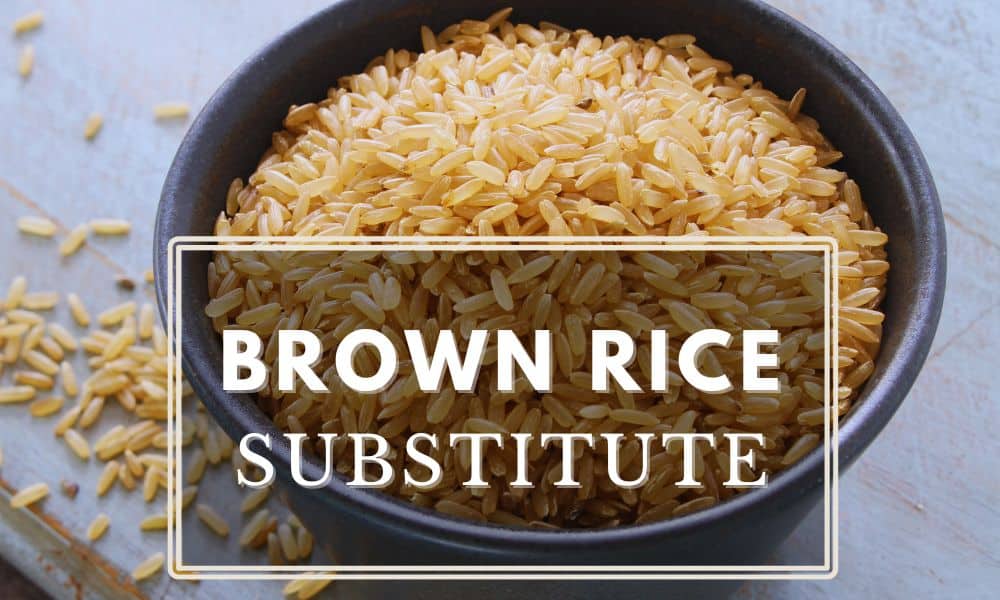When discussions of healthy rice come up, we immediately think of brown rice.
Associating brown rice with “healthy” is all too common.
But did you know that there are substitutes even healthier than brown rice itself?
For others, they’re just another bag in the grocery store. Carelessly glanced over, but never the one picked up and bought.
But brown rice is just one way of going about the healthy path.
What is Healthier than Brown Rice?

A single cup of cooked brown rice has:
- 4.52 grams of protein
- 3.51 grams of fiber
- 45.8 grams of carbohydrates
- 218 grams of calories
But there are several brown rice substitutes for you to choose from.
And each of them has their own winning nutritional attributes:
Quinoa
Okay, so it’s technically a seed and pronounced as keen-wah.
Quinoa is a complete protein powerhouse boasting all nine amino acids. It also has fewer carbs than brown rice.
A single cup of cooked quinoa has:
- 8 grams of protein
- 5 grams of fiber
- 39 grams of carbohydrates
- 222 grams of calories
It’s also a fantastic brown rice substitute because of its quicker cooking time, which is just 15-20 minutes. Brown rice takes about 45 minutes.
Farro
Also known as the ancient grain, farro is a wheat with a nutty flavor and chewy texture. It is packed with nutrients that make for a hearty and satisfying brown rice substitute.
A single cup of farro offers:
- 6 grams of protein
- 5 grams of fiber
- 37 grams of carbohydrates
- 216 grams of calories
Farro cooks for 30-40 minutes.
Barley
Barley isn’t gluten-free, unlike brown rice. But it has twice the calcium and fiber as brown rice.
A single cup of cooked barley includes:
- 6 grams of protein
- 6 grams of fiber
- 35 grams of carbohydrates
- 200 grams of calories
Barley cooks for 30-45 minutes, but soaking it before cooking can significantly reduce that time.
Wild Rice
So it’s not actually a type of rice. Wild rice is an aquatic grass seed. It is very dark in color, while brown rice is lighter tan.
A single cup of cooked wild rice has:
- 6 grams of protein
- 3 grams of fiber
- 36 grams of carbohydrates
- 160 grams of calories
When it comes to cooking time, wild rice takes longer than brown rice. Wild rice cooks for about an hour.
Oats
Oats are whole grains packed with nutrients and fiber. They’re a versatile brown rice substitute that serves as an incredible base for both sweet and savory dishes.
A single cup of cooked oats provides:
- 5 grams of protein
- 4 grams of fiber
- 30 grams of carbohydrates
- 150 grams of calories
Oats are known to cook quickly and easily, making them a convenient option for busy people.
Instant oats are the quickest at just 1-2 minutes, while rolled oats cook for 5-10 minutes.
What is a Good Substitute for Rice for Weight Loss?

Because of its high fiber content, brown rice is good for weight management. It promotes satiety and aids in digestion.
But brown rice isn’t your only option. Here are other brown rice substitutes for weight loss:
Cauliflower Rice
If you’re looking for a low-calorie and low-carb alternative, then cauliflower rice is for you.
A cup of cooked cauliflower rice has:
- 2 grams of protein
- 2 grams of fiber
- 5 grams of carbohydrates
- 25 grams of calories
What’s more, you can easily make cauliflower rice at home, too. Just pulse the cauliflower florets in a food processor until they resemble rice, and you’re good to go.
Freekeh
Next up is a green whole grain filled with nutrients. Freekeh is made of young green wheat that’s toasted and cracked.
Its versatile flavor allows for a variety of dishes like pilaf and soups.
A cup of cooked freekeh has:
- 12 grams of protein
- 8 grams of fiber
- 40 grams of carbohydrates
- 220 grams of calories
Freekeh’s high protein and fiber make it a great brown rice substitute for weight management.
Shirataki Noodles
This unique low-calorie substitute is made from konjac yam. Shirataki noodles are almost calorie and carb-free.
A cup of cooked shirataki noodles has:
- 0 grams of protein
- 1 grams of fiber
- 1 grams of carbohydrates
- 10 grams of calories
Since they are low in carbs, pair shirataki noodles with healthy fats and protein-enriched dishes to create a balanced meal.
What is a Good Substitute for Digestion?
Due to brown rice’s high fiber content, it can be tough on digestion for some. Here are some alternatives:
Millet
Millet is another ancient grain that has been cultivated for thousands of years.
Both millet and brown rice are whole grains. However, millet is easier to digest because its fiber is gentler on the digestive system.
Brown rice contains a fiber called phytic acid, which affects mineral absorption. This can then cause digestive discomfort for some people.
A cup of cooked millet has:
- 3.5 grams of protein
- 5 grams of fiber
- 35 grams of carbohydrates
- 170 grams of calories
Buckwheat
Yeah, it’s not a grain.
Buckwheat is actually a pseudocereal. This means that buckwheat is a seed that’s related to rhubarb.
Buckwheat also has a good amount of fiber and protein that aid in digestion. Its lower phytic acid content than brown rice makes it easier to digest.
A cup of cooked buckwheat has:
- 5.6 grams of protein
- 4.5 grams of fiber
- 33.5 grams of carbohydrates
- 155 grams of calories
What is a Good Substitute for Texture and Flavor?
Brown rice has a chewy texture. It offers a firmer bite compared to white rice’s soft and tender texture.
When it comes to taste, brown rice has this distinct, earthy flavor.
Substitutes with similar texture are quinoa and wild rice
Those with similar flavors are barley and farro.
But if you’re looking for a different texture and flavor, try cauliflower rice or shirataki noodles.
What Brown Rice Substitute Has Quicker Cooking Time?
Brown rice usually cooks for 40-45 minutes.
White Rice
The cooking time of white rice is relatively shorter than that of brown rice’s. Stripped of the bran, white rice absorbs water easily and only needs about 15-20 minutes to cook.
And yes, that’s for both long-grain and short-grain rice varieties.
Parboiled Rice
This type of rice has been partially boiled in the husk. The process involves:
- Soaking the rice in water
- Steaming the rice
- Drying the rice out before removing the husk
Parboiled rice is usually more yellowish than regular white rice.
It takes around 25-30 minutes to cook.
Rice Beyond the Beige
Having variety is good. You’ll come to find that it’s healthier.
It’s a way to spice up the kitchen (and our lives)!
Having the same old brown rice can be tiring. More so now that we know that there are healthier alternatives to try.
Trust your taste buds (and your gut). When have they ever led you down a bland path?
Besides, cooking good food can also mean cooking something healthy. It’s a culinary adventure, for heaven’s sake!
Think of brown rice as a safety net. For now, go experiment with the healthier alternatives…
Frequently Asked Questions
1. What’s the difference between white and brown rice?
Think of brown rice as white rice’s natural state, where the bran and germ layers remain intact.
White rice only becomes white rice after the milling process it undergoes. This extra processing causes white rice to lose some of its nutrients.
2. Is brown rice gluten-free?
Yes, brown rice is gluten-free.
3. Can I combine different substitutes for better nutrition?
Yes, you can. Mixing several alternatives can provide a wider range of nutrients. Feel free to experiment to find what taste you like.
4. Are there gluten-free substitutes for brown rice?
Yes. You can start with quinoa and millet.
5. Can I enhance the flavor of brown rice substitutes?
Of course! You can add herbs, spices, and sauces.
Related articles:

